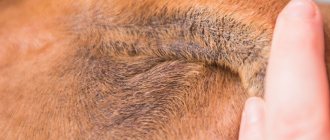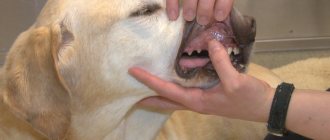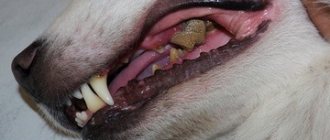Reasons for the development of nephritis
Veterinary practice shows that the most common causes of kidney inflammation in dogs are the following:
- Past infectious diseases . Pathogenic microorganisms that cause infections such as leptospirosis, canine distemper, viral hepatitis and enteritis, as a rule, lead to the development of nephritis. Pathogenic bacteria and viruses enter the kidneys through the bloodstream or lymphogenous route. In this case, the disease is considered as a complication after an infection.
- Hypothermia. A long walk in bad weather, walking decorative dog breeds in unfavorable weather conditions without protective clothing, bathing a pet in open bodies of cold water, keeping a pet in damp, unheated rooms are the main causes of the development of inflammatory processes in the kidneys. A weakened immune system makes the situation worse.
- Helminthiases. Helminthic infestations lead to intoxication of the body with waste products of parasites, which is accompanied by dysfunction of the excretory system and the development of inflammation in the kidneys.
- Intoxication . Poisoning of four-legged friends with poisonous plants, toxic fumes, household pesticides, pesticides, and solvents is a common cause of the development of renal pathology. Toxic substances are mainly excreted through the kidneys, damaging their cellular structure and disrupting the normal processes of formation and excretion of urine.
- Insect bites . Biological poisons and toxins from bites of midges, bees, and ticks have a pronounced nephrotoxic effect. By affecting the kidneys at the cellular level, toxins lead to the development of diffuse inflammation.
- Injuries . As a result of mechanical damage or compression of organs, an inflammatory reaction occurs in the renal tissues.
- Use of medications. Arsenic-containing medications, creolin and other medications can harm the body's excretory function.
Veterinarians also note cases of nephritis in dogs that have been eating spoiled food for a long time. The risk group includes stray animals and dogs of decorative breeds with poorly developed undercoat.
We recommend reading about how to boost your dog’s immunity. You will learn about the causes of low immunity in dogs, signs of this condition, recommendations, vitamins and folk remedies to improve the condition of your pet. Find out more about treating colds in dogs here.
Common kidney diseases in dogs and their treatment
1. Glomerulonephritis is inflammation of the kidneys not associated with infection. The cause may be an extensive wound, allergies, inflammation of internal organs, or a previous infectious disease. First of all, the renal glomeruli are affected, then adjacent tissues are involved in the process. Symptoms: high blood pressure, swelling of the paws and/or chest, red urine, high temperature, lower back pain.
Hormones (prednisolone, dexamethasone, etc.) are used to reduce inflammation. Antibiotics are prescribed to prevent a possible infection or suppress an existing one. To relieve pain - papaverine or no-spa, to stop bleeding - dicinone, vikasol. Be sure to limit exercise, develop a diet and prescribe auxiliary medications (for example, herbal collection “Healthy Kidneys for Dogs”, “Stop Cystitis”, etc.).
2. Pyelonephritis – inflammation of the kidneys of a bacterial nature. Causes: penetration of pathogenic bacteria into the kidneys (staphylococcus, Escherichia coli or Pseudomonas aeruginosa, etc.). In rare cases, the culprit is a fungus or virus. Pyelonephritis can develop as a complication of cystitis, venereal disease, purulent inflammation of any internal organ. Symptoms: high blood pressure, poor appetite, lethargy, stiff gait, high temperature.
To improve the general condition - painkillers, antispasmodics, blood pressure-lowering drugs, homeopathic or herbal preparations. To fight infection - a long course of antibiotics (ciprofloxacin and analogues), immunomodulators to increase the body's defenses.
3. Nephrosis - damage to the renal tubules, due to which protein metabolism is disrupted, filtered toxins are not excreted, but enter back into the blood. The causes are any viral disease (nephrosis as a complication), congenital defect (amyloidosis of the kidneys, etc.), systemic disorders, acute poisoning, tumors, ineffective or untimely treatment of the kidneys in dogs with nephritis and other diseases of this organ.
The renal pelvis is dilated in the fetus: possible causes and health consequences
An ultrasound examination, which every pregnant woman should undergo, is not only a way to “get to know” her baby, but also a method for diagnosing most intrauterine pathologies and congenital anomalies. According to statistics, one of the common problems at this stage of development is pyeloectasia - expansion of the renal pelvis. It is detected in approximately 2% of all pregnancies. What may be associated with renal pyeloectasia in the fetus, is this condition dangerous, and does it require treatment: let’s try to figure it out.
Symptoms of pathology in dogs
The action of one or another negative factor leads to spasm of blood vessels in the kidneys and the development of ischemia. Increased production of the hormone renin leads to a narrowing of the lumen of blood vessels, impairing their permeability.
The pathological process as a whole leads to general hypertension, azotemic uremia, chronic renal failure. Products of protein metabolism - urea, creatinine - accumulate in the body, which is accompanied by intoxication. All this is manifested by the following symptoms:
- Increase in body temperature by 1 - 1.5 degrees. The dog has a hot and dry nose and increased thirst.
- The general condition is depressed. A sick animal is lethargic, apathetic, avoids active physical activity, and is reluctant to go for a walk.
- Appetite is reduced or completely absent.
- Change in posture - the dog arches its back unnaturally and takes a forced position.
- Pain syndrome. When palpated in the lumbar region, the dog shows anxiety and even aggression. Often a sick animal tries to bite the owner when stroking the back.
- Violation of the act of urination. The chronic form of the disease is often accompanied by polyuria. In acute nephritis, on the contrary, urine production decreases, anuria or oliguria is observed. When urinating due to pain, the dog takes unnatural positions, whines, and worries. The inflammatory process is accompanied by frequent urination. The urine is cloudy.
In severe cases, brown urine is observed due to the presence of blood in it due to damage to blood vessels and the release of red blood cells. The content of pus in the urine is due to the action of pathogenic microflora in the kidney tissues.
- The color of visible mucous membranes changes from a healthy pink to pale or bluish.
- Swelling in the abdomen, thighs, submandibular and groin areas is caused by the retention of salt and water in the tissues due to increased production of antidiuretic hormone.
- General intoxication of the body is accompanied by vomiting, an unpleasant uremic odor from the pet, constriction of the pupils, convulsions, and in severe cases, paralysis. Dyspepsia is one of the manifestations of intoxication of the body with protein breakdown products.
High levels of nitrogenous substances negatively affect the body's respiratory system, causing inflammation. In this regard, dogs with nephritis often show symptoms of bronchitis and bronchopneumonia.
Common symptoms of kidney failure
Kidney diseases in dogs are accompanied by general symptoms, but there are also manifestations that are characteristic only of a certain type of pathology. External manifestations of renal failure include the following symptoms:
- lethargy and fatigue of the animal;
- decreased appetite;
- weight loss;
- pallor of mucous membranes;
- dry skin;
- pain on palpation in the lumbar region and when urinating;
- drop in visual acuity;
- violation of behavior and coordination of movements;
- increased urge to urinate with a decrease in the volume of urine produced (oliguria), up to complete cessation of urination (anuria);
- fluid retention in the body leads to the formation of edema;
- there are signs of heart failure (especially with glomerulonephritis);
- inflammatory processes are accompanied by an increase in body temperature;
- poisoning with decay products leads to vomiting, stool upset, and convulsions.
Laboratory tests of urine record changes in its composition, volume, color:
- urine becomes dark and cloudy;
- urine density is reduced;
- in the urine the presence of: protein, blood, desquamated epithelial cells, protein casts is noted; a high content of leukocytes indicates the bacterial nature of the disease.
Clinical blood tests indicate the following changes:
- increased levels of urea and creatine, which indicates acidosis;
- high content of minerals - potassium, magnesium, phosphorus and a decrease in calcium and sodium;
- moderate decrease in the number of red blood cells (anemia);
- increased number of neutrophil leukocytes;
- increase in ESR.
The progression of pathology leads to increased intoxication with decay products, disruption of water-salt homeostasis and pH of the body, a decrease in metabolic processes, increased protein breakdown and disruption of plastic processes. Lack of treatment leads to an increase in pathological changes and death of the dog.
Aplasia
Kidney aplasia is a congenital anomaly in which the organ is an underdeveloped rudiment lacking normal renal structure.
With unilateral aplasia, the function of the atrophied organ is taken over by the second kidney. Due to long-term compensatory work, it hypertrophies (increases in size). The disease does not manifest itself symptomatically. It can be discovered randomly during an ultrasound of the abdominal organs.
Bilateral aplasia is an anomaly that is not compatible with life. The kitten dies in utero or in the first two to three days after birth due to renal failure.
What it is?
This is the name of a very unpleasant and potentially fatal pathology. Its meaning lies in the degeneration, degradation and atrophy of normal renal tissue . As a result, the organ turns into a “lump” of whitish color and flabby consistency.
This “ersatz” cannot perform its natural functions, as a result of which the animal dies due to severe renal failure . As a rule, the degenerative process is irreversible. All phenomena accompanying the development of this disease are united by the term “nephrotic syndrome”.
Important! In advanced cases, it is recommended to euthanize the sick animal, since it is impossible to cure practically absent kidneys.
Nephrotic syndrome in dogs is accompanied by edema . In severe cases (photo below), abdominal dropsy and ascites .
Shortness of breath is also characteristic, and pulmonary edema may occur. The first sign of something wrong is shortness of breath . For “normal” breeds of dogs (not brachycephalic), it is not physiological; when it appears, you should urgently show your pet to an experienced veterinarian. What other symptoms of nephrosis in dogs are there?
Kidney problems often lead to eye pathologies - usually glaucoma, caused by a sharp increase in intraocular pressure. Since the kidneys are responsible, among other things, for the production of erythropoietin (a substance that promotes the production of red blood cells), the classic sign of nephrosis is progressive anemia.
Classification
In veterinary medicine, it is customary to divide nephritis in animals according to the nature of the process into acute, subacute, chronic and subchronic. The chronic form of the disease is a complication of acute nephritis. In the chronic course of the disease, hyperthermia is galloping in nature, and the symptoms of intoxication are weakly expressed. The acute form of the disease is accompanied by a feverish state, pronounced intoxication, and the rapid development of uremia.
Based on the form of the pathological process, veterinary specialists distinguish between diffuse and focal nephritis. In the first case, the inflammatory process affects all kidney tissues - the pelvis, parenchymal tissues and the vascular network of the glomeruli.
In the case of focal pathology, inflammation is localized in individual glomeruli. This form of the disease passes without hypertensive phenomena and edema. The blood flow in focal nephritis is not disturbed, and the symptoms of intoxication in the animal are not observed in this regard.
Symptoms of glomerulonephritis in dogs
Depending on the course of the disease, there are several stages - acute, subacute and chronic.
The chronic form of glomerulonephritis is diagnosed quite rarely and proceeds slowly over several years with periods of exacerbation. There are many signs of the development of glomerulonephritis in pets, so in veterinary practice entire syndromes are separated. The main ones are:
- The acute form of the inflammatory process is manifested by the following symptoms - pain in the lumbar region, abdominal pain, increased body temperature to high levels, a small amount of urine excreted - oliguria, a change in the color of urine (it becomes red or the color of meat slop with blood streaks) . The presence of protein in the excreted portion of urine is also noted.
- The syndrome of cardiovascular disorders against the background of glomerulonephritis is manifested by shortness of breath, increased pressure in the arteries, changes in heart function (acute failure of the left ventricle of the heart). The dog may develop asthma, swelling in the pulmonary structures, bradycardia and narrowing of the arterioles, swelling in the optic nerve, and hemorrhages in the eye.
- Edema syndrome is characterized by the presence of edematous phenomena of a pasty type (especially localized in the hordeum), the development of hydrothorax, and the accumulation of fluid in the abdominal cavity (ascites).
- Cerebral syndrome is a dangerous manifestation of glomerulonephritis in dogs. There is pain in the head, attacks of nausea and eruption of gastric contents. The pet is weak, vision decreases, and excitability in the muscles and nerve fibers increases. There is also a change in sleep, the animal behaves restlessly, and hearing decreases. In the last stages of the manifestation of cerebral syndrome with inflammation of the glomeruli of the kidneys, eclampsia, convulsions, spasms of the respiratory system, loss of consciousness, and a depressed state develop. The visible mucous membranes are cyanotic, the dilation of the pupils is clearly visible, foamy saliva flows from the mouth, sometimes mixed with blood. Breathing becomes noisy and harsh, the pulse is thready, and the pressure in the arteries is increased.
Lack of timely treatment of inflammation in the glomeruli of the kidneys can lead to dangerous complications in the form of heart failure, edema of the pulmonary structures, loss of consciousness, even the development of convulsive phenomena, and cerebral hemorrhages.
The appearance of specific symptoms in a dog is a reason to immediately show your pet to a veterinarian. Diagnosis is possible only in a clinical setting.
At the veterinary hospital, a specialist will conduct a number of necessary studies and tests. Taking an anamnesis is absolutely important - the specialist will ask the owner whether the animal has suffered from serious purulent sore throats or whether there is high blood pressure. Diagnostics includes:
- general blood analysis;
- general urine analysis;
- blood biochemistry;
- ultrasound examination of organs located in the abdominal cavity (particular attention is paid to the kidneys).
If the owner seeks help in a timely manner, the chances of a successful treatment for the pet are quite high. With correctly prescribed therapy, complete recovery occurs within several months, sometimes treatment is delayed and lasts up to 1 year.
Glomerulonephritis is rare, but becomes chronic with frequent exacerbations. This directly depends on the individual characteristics of the pet, the addition of infectious factors, active physical activity and hypothermia. The lack of timely assistance can result in not only complications for the animal, but also provoke the death of the dog.
Special cases of the disease
The consequences of kidney disease during pregnancy should be considered, since this topic is especially exciting for expectant mothers. Moreover, they cause discomfort, which creates an additional reason for stress for a woman. There are two types of occurrence of this disease:
| Before pregnancy | During pregnancy |
| In this case, doctors order a full examination and leave the woman under constant medical supervision, since the stage of the disease could have moved forward long ago, and the consequences could be irreversible for both the pregnant woman and the unborn baby. In extreme cases, a decision may be made to terminate the pregnancy. | Here, special importance is attached to the presence of infections in the body, which can be treated. The pregnant woman is prescribed complete rest and the necessary medications are prescribed, which indicates the possibility of conservative treatment. The main thing is to prevent the disease from becoming acute, otherwise the outcome will not be happy at all. |
During such a period, the expectant mother simply needs the care of loved ones. Especially considering the fact that physiological and mental health are closely interconnected. Timely visit to the hospital can prevent the worst consequences, so never delay going to the doctor. Firstly, his consultation will help you monitor your health, and secondly, you will protect not only yourself, but also your loved ones, in particular, children.
Diagnostic methods
Having discovered symptoms of nephritis in a four-legged friend, the owner should immediately contact a specialized institution. A veterinarian, in addition to a general examination of the animal, palpation of the kidney area, tonometry, will prescribe a clinical blood and urine test.
Red and white blood cells, renal epithelium and salts are found in urine. Proteinuria and hematuria are characteristic conditions for kidney inflammation. A clinical blood test usually shows an increased level of protein, leukocytes and creatinine.
An effective tool in making a diagnosis is ultrasound examination. The method allows you to identify the localization of inflammation, estimate the size of the diseased organ, and detect destructive changes in the parenchyma.
Ultrasound
Contrast x-rays and a kidney biopsy can help make the diagnosis. The disease should be differentiated from nephrosis, pyelonephritis, urolithiasis, and inflammation of the bladder.
Norms for ultrasound of fetal kidneys
Normally, a longitudinal ultrasound scan reveals the fetal kidneys as a bean-shaped or oval formation located in the lumbar region. On a transverse scan they have a round shape and are identified as paired formations on both sides of the spine.
One of the structural units of the kidney is the calyces, which, merging with each other, form one common cavity - the renal pelvis. Gradually narrowing, the pelvis continues into the ureter. The ureter drains into the bladder.
Using an ultrasound machine, the doctor can visualize the pyelocaliceal system starting from the 14th week of intrauterine development. Normally, the diameter of the renal pelvis should not exceed:
- in the second trimester – 4-5 mm;
- in the third trimester – 7 mm.
Examination of the internal structure of the organ becomes possible after 20–24 weeks of pregnancy. During this period, it is already possible to diagnose some developmental anomalies:
- agenesis (absence of one or both kidneys);
- atypical location of the organ (dystopia);
- increase in size;
- expansion of the calyces and (or) renal pelvis;
- cystic changes in the kidneys.
The fetal ureters are not normally visualized.
Treatment of acute and chronic forms
Therapy for infectious kidney inflammation necessarily includes the use of antibacterial drugs. The best option would be to prescribe antibiotics after a microflora sensitivity test. In veterinary practice, in the treatment of acute forms of nephritis, penicillin antibiotics, cephalosporins, and tetracyclines are used.
Among penicillins, Ampicillin, Amoxicillin, Ampiox have a good effect against renal infection. Of the cephalosporins, veterinarians use Cephalosporin, Cephalexin, Cobactam, Cefazolin for acute nephritis.
The drugs are active against streptococci and staphylococci, the most common causes of nephritis in dogs. Tetracycline drugs, such as Doxycycline, have a bactericidal effect on most pathogenic microorganisms that cause inflammation in the kidneys.
Antibiotics for the treatment of nephritis in dogs
Sulfonamides and nitrofurans have a good therapeutic effect for nephritis in dogs: Sulfalene, Sulfadimethoxine, Norsulfazole, Furadonin. If the level of urea in the blood is more than 25 mmol/l, treatment is carried out only with nitrofurans that have a small molecular weight: Furazolidone, Furagin. The course of treatment with antibacterial drugs is at least 10 - 14 days.
In the acute form, it is important to immediately detoxify the body. For this purpose, the animal is prescribed intravenous infusions of glucose solution, calcium chloride, saline solution, and rheopolyglucin.
Treatment of acute and chronic forms of the disease involves the use of diuretics: Potassium acetate, Furasemide, Clopamide, Ammonium chloride. As diuretic drugs, on the recommendation of a doctor, a sick dog can be prescribed herbal preparations in the form of bearberry decoction. The animal is also prescribed sedatives and, if necessary, painkillers, for example, Baralgin, Spazgan, No-shpa.
For high blood pressure, dogs are given reserpine. In case of symptoms of heart failure, drugs such as digitalis, Cardiamin, and Caffeine are used.
The success of treating kidney inflammation depends not only on the use of medications. It is of no small importance to follow a 24-hour fasting diet followed by transferring the animal to a low-protein diet. Until complete recovery, the dog is fed cereals and vegetables, low-fat fermented milk products. It is recommended to give meat in the diet in the form of broths. Salt is strictly prohibited.
For information on the causes, symptoms and treatment of nephritis in dogs, watch this video:
Causes of pathology
The kidney structures are represented by a whole system consisting of microscopic small filtering units. The glomeruli perform an important task, releasing the blood circulating throughout the body from products formed during metabolism, excess minerals and toxic substances. The task of the structural units of the kidneys is also to absorb excess nutrients produced from primary urine, which resembles blood plasma in properties.
When the normal functioning of the kidneys is disrupted, the body not only develops intoxication with metabolic products, but also develops exhaustion, triggered by the removal of protein components and sugar along with urine from the body.
The inflammatory process in the structural units of the kidneys is called glomerulonephritis. A pathological process develops as a result of the active activity of pathogenic microflora and parasitic diseases. Also, the cause of the development of the inflammatory process is oncology, problems in the functioning of the immune system, intoxication with various poisons or medications. If the cause of the development of glomerulonephritis in a dog cannot be identified during laboratory and instrumental studies, the pathology is idiopathic in nature.
The greatest danger in the development of glomerulonephritis is the development of a sharp loss of proteins through urine excreted from the body. Proteinuria is also considered one of the most pronounced symptoms of the development of inflammation in the glomerular apparatus of the kidneys. In the absence of therapy, a prolonged course of the pathology leads to serious complications in the form of kidney failure, which cannot be completely cured. Glomerulonephritis is diagnosed in dogs regardless of age and gender.
An acute form of pathology develops in pets when infected with various viruses or bacteria. The main causes of the development of infectious glomerulonephritis are leptospirosis, viral hepatitis, adenoviral infection, canine distemper virus, streptococcus, staphylococcus, pneumococcus, Pseudomonas aeruginosa, rhinotracheitis.
The development of systemic allergies can provoke the occurrence of glomerulonephritis in a pet. A similar pathology occurs when exposed to toxic substances from infectious pathologies. Various pathogenic microorganisms and viruses penetrate into a susceptible body in two main ways - lymphogenous, hematogenous, and also from nearby tissues. The most common cause of glomerulonephritis in dogs is an infection of the reproductive system.
Nephrotoxins are among the causes of the development of pathologies in the kidneys. Toxic substances such as heavy metals, zinc phosphides, zoocoumarins, mineral and chemical fertilizers easily penetrate into the blood, filtering in the kidneys and causing severe changes. In addition to the above reasons for the development of inflammation in the renal glomeruli, there are:
- violation of the mode and type of feeding;
- unsatisfactory living conditions for the animal (being in drafts, high humidity, cold floor);
- previous surgical interventions;
- mechanical injuries;
- active physical activity;
- hypothermia when swimming in cold water;
- introduction of some vaccines, serums, antimicrobial agents, immunoglobulins in violation of technology.
Toxic substances from pathogens - viruses and microbes (especially with streptococcal infections) lead to damage to the membrane of the basal capillary part of the glomeruli. Specific autoantigens develop in the animal's body.
If the dog has been exposed to the cold for a long time, this can cause an exacerbation of the allergic reaction; immune complexes appear, deposited on the basement membrane. Mediators of the inflammatory process are released, lysosomes are damaged, which leads to disruption of general microcirculation and the release of lysosomal enzymes. The immune reaction provokes an inflammatory process.











